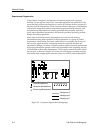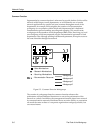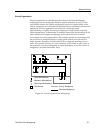
Network Design
5-2 The Role of the Workgroup
As this Networking Guide is concerned with the decisions made regarding
networking hardware and not with the administration of networks or the specific
uses to which they are put, several aspects of the overall process of network
design are not treated in this document, such as the selection of a Network
Operating System (NOS), the choice of applications or of workstation types, or
other specific decisions generally out of the purview of Cabletron Systems as a
provider of networking hardware. These aspects of network design will, however
have an impact on the performance of networks, and should be fully investigated
before designs are attempted.
The Role of the Workgroup
A workgroup is a group of network end stations that are related in some way. The
conditions of this relationship are determined by the Network Manager, and can
be based on anything from device type to user occupation or even device color. As
the workgroup is the operating portion of the network, where information is
created and given direction, the workgroup is the portion of the network that
creates traffic and network congestion. As such, it is the most complicated portion
of the network to design.
Very few networks are made up of one workgroup. It is a mistake, however, to
underestimate the importance of a properly designed and well-planned
workgroup, as the vast majority of enterprise networks are collections of
workgroups that are connected to one another. The various workgroups all have
different needs and implementations, and are tied together to form a cohesive and
capable enterprise network. A logical, well-thought-out workgroup plan and a
skillful execution of the creation of workgroups according to a firm set of criteria
goes a long way toward ensuring that the network which results will be
functional, flexible, reliable, and sufficiently robust to handle the demands placed
on it by users.
The idea of the workgroup in the network roughly translates to the use of
segmentation. Ideally, segmentation should be planned between separate
workgroups or between collections of related workgroups, not within
workgroups. The workgroup concept divides the network according to a cohesive
plan in the interests of reliability, efficiency, or ease of recovery. While all of these
are important factors in the operation of the network, certain choices made in the
design of networks, from technology and topology to the organization of stations
and the segmentations method used if any, will improve some aspects of the
network at a cost to others. Striking the proper balance of these factors is the
responsibility of Network Managers, who must investigate and determine the
needs and preferences of the proposed network’s users.
NOTE
This chapter does not discuss the relative merits of one
networking technology over another. For information on the
different strengths of the available technologies, refer to the
Cabletron Systems Networking Guide - MMAC-FNB Solutions.


















